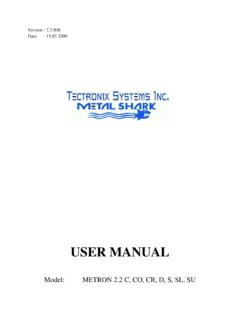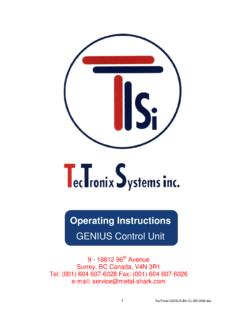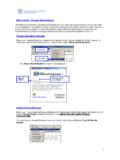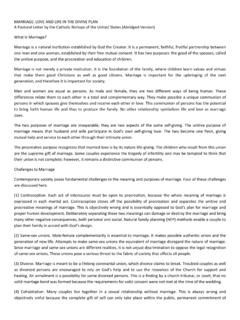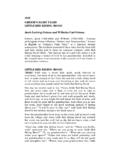Transcription of Version : 1.3.006 Date : 24.03 - metal-shark.com
1 Version : Date : USER MANUAL Type: METRON C, CO, CR, D, S, SL, SU, V, VT Dear customer, To begin with, we would like to thank you for your confidence in our metal detection system. Prior to switching the system on, please read the user manual completely as this provides you with the expertise necessary for optimum operation and adjustment of the system according to your requirements. In addition, you learn all about the sophisticated options provided by the AMD 01 electronics as well as about the optional extensions. If, contrary to expectations, you have any problems in operating your system, the TECTRONIX SYSTEMS team and our contractors will be able to assist you at any time. The TECTRONIX SYSTEMS team is at your disposal from Monday until Friday between 8 and 5 , tel. (604) 607-6028 or fax (604) 607-6026.
2 If a demonstration on site is required, we will respond as soon as possible offering national and international services. Enjoy your TECTRONIX SYSTEMS metal detector, Yours truly, TECTRONIX SYSTEMS INC. Unit 9 18812 96th Avenue Surrey, BC Canada V4N 3R1 Telephone (604) 607-6028 Fax (604) 607-6026 E-mail (Sales) E-mail (Service) Internet Index General: O - Principle of Operation ---------------------------------------- --------------------------------- O1 - Block Diagram--------------------------------- ---------------------------------------- ------------O2 Preparation: A - Mounting ---------------------------------------- ---------------------------------------- --------- A1 - Installation Do's and Don'ts---------------------------------- ----A1/1 - Connections: Electronic board ---------------------------------------- ----------------------- A2 - Power supply selection ---------------------------------------- --------------------------------- A3 Starting + Change over to other products B - Normal Operation ---------------------------------------- -------------------------------------- B1 - Adjustments----------------------------- ---------------------------------------- ----------------- B2 - Sensitivity----------------------------- ----------------------------- B3 - Reject duration / Noise suppression ---------------------------- B4 - Product compensation ---------------------------------------- ---- B5 - Outputs ---------------------------------------- --------------------- B6 Faults and Problems C - General treatment of failures ---------------------------------------- ------------------------- C1.
3 Internal faults ---------------------------------------- ---------------------------------------- --- C2 - Power supply ---------------------------------------- ---------------------------------------- ---- C3 - Troubleshooting ---------------------------------------- ---------------------------------------- - C4 - Test points---------------------------------- ---------------------------------------- -------------- C5 Appendices D - Who, What, How, When, Why ---------------------------------------- ------------------------ D1 - Connecting External Devices--------------------------------- ---------------------------------- D2 - Dimensions------------------------------ ---------------------------------------- ------------------- D3 - Belt Conveyor/Noise Suppression Settings-------------------------------- ------------------ D4 Spare Parts E - Spare part drawings-------------------------------- ---------------------------------------- ------ E1 - Spare part lists----------------------------------- ---------------------------------------- ---------- E2 Legend LED dark Ground RF-Signal Metal ball Move Next step Product Snap switch position Don t twist the snap switch position Measuring signal Switching threshold LED
4 Lights Cable LED flashes Metal detector Principle of Operation Metal detection As metal enters the detection field, the measuring signal moves in one direction As metal leaves the detection field, the measuring signal moves in the opposite direction O1/1 electromagnetic field Product line R1 T R1 T Metal piece Transmitter coils Receiver coils R1 T R1 T R1 T R1 T R1 T R1 T Switching Measuring Exceeding both threshold values, metal is identified. Block diagram: Junction box Junction box O1/2 Outputs V A active output Metal relay Fault relay U 22 - 26 I 300 mA Detection coils Receiver / Amplifier unit Transmitter unit Self monitoring Eject duration Comparator Noise suppression Product Compensation AMD 01 Installation Do's and Don'ts Electrical - Do Not cut the connector or the power cables These cables are equipped with special double shields and connectors and must not be cut.
5 If you require longer or shorter cables please order them from our parts department. The electrical cables are approximately 10 feet (3m) in length and the connector cables are 26 feet (8m). It is therefore recommended that consideration be given to where the connection boxes are located and that all cables be installed in conduit. - Do Not weld in reasonable proximity to the metal detector Welding in the vicinity of the metal detector will trigger faults. - Run a clean, constant voltage power supply from the main to the control panel Voltage fluctuations can cause false tripping therefore a constant voltage transformer is highly recommended. - Do Not install the metal detector near MCC's or control panels Stray fields can trigger faults. - Run the connector cables to the metal detector separately Connector cables are part of the metal detector and have to be protected against noise.
6 It is highly recommended to run them in a dedicated conduit. Both cables can be run in the same conduit. The conduit should be metal but, must be grounded. If the conduit is to be connected at the transmit/receive boxes on the coil and/or the control panel, all fittings must be plastic. - Do Not install the detection coil inside an electromagnetic field (Strong power supply fluctuations) Interferences can trigger faults. For example; where units are installed in close proximity to chipper motors, when under high amperage draw, can cause nuisance or false tripping and this may require the fabrication of a shield. - Do Not disconnect the metal detector from the power supply main A constant, uninterrupted power supply enables more sensitive adjustments. Powering the unit on and off causes it to recalibrate during which time metal will not be detected.
7 - When welding, do not use the control panel mounting surface as a ground Mechanical - Do Not use conductive (Anti-Static) belt material Non-conductive belt material is preferred. When splicing belts, use a "Finger over Finger" splice for best results. Ensure all surfaces are clean and free of debris at the splice. - Vibration-less installation of the detector coil (except "VT") Higher sensitivities can be attained and maintained if the operating conditions are optimal. Ensure the coil is mounted to a structure that is stationery at all times. - Eliminate loose metal-to-metal connections near or within the detection field Intermittent metal-to-metal contacts from such things as roller axis, loose bolted connections, or broken welds can cause the metal detector to false trip especially on the higher sensitivity settings. - Vibration-less installation of the Control Panel Mount the control panel on a vibration free surface.
8 Vibration can cause premature electronic component failure . - Avoid cable On "VT" Vibratory Conveyor installations, use the supplied cable clamps and tie wraps to secure the cables to the metal detector housing. Doing so will avoid whip lash at the transmit/receive box strain relief connections. In addition to this we recommend that you loop the cables as they exit the conduit. These loops will then flex as the conveyor cycles. It is also advisable to follow this procedure on belt conveyor installations. - Do Not touch the sensor/coil surface of the detector Mechanical contacts may cause detection errors. Keep the sensing surface free of debris. - Mount the FLAT PLATE type coils as close as possible to the underside of the vibrating conveyor or belt conveyor The closer the coil to the product being conveyed, the greater the sensitivity. Do not allow material to build up on the sensing face so that it touches the conveyor pan.
9 Doing so creates a closed conductive loop and the metal detector will false trip. - Isolate rollers on belt and driven roll conveyors On belt and roller conveyor applications where a roller is less than 24" (610mm) from the centerline of the detector, the roller must be isolated on one side to avoid the possible effect of errant static charges. Use a UHMW shim beneath the bearing and nylon washers or some other non-conductive material beneath the bolt head and nut/flat washer. The bolts should also be sleeved with a non-conductive material. It may be necessary to isolate more than one roller in either direction to achieve the desired results. A1/1 Connections at Detector 1 Junction box transmitter Detector head 2 Junction box "receiver" 1) "Transmitter" A1/2 8 1 2 8 2 1 black green / yellow white / brown 2) "Receiver" A1/3 4 1 2 3 8 2 1 3 4 yellow green black brown white Connections at Control Panel a) Receiver 2726252423+ 8V- 8V~43218 A2/1 AMD 01 a b c d2 e f g d1 h yellow green brown white black b) Transmitter ~218222120 c) Active-output / Reset 1918171615= 300 mA => see page A2/6=> see page A2/7 GNDUoutUoutReset1 Attention: Connect onlyfloating relay contactsActive-output:Imax The voltage at the active output and Uout is not controlled.
10 It changes for a loadpower of 0 300 mA between 26 V and 22 V (supply voltage at 230 V / 115 V). d) Option plug d1) d2) A2/2 38 37 36 32 31 30 41 40 39 35 34 33 green white black e) Self Monitoring Relay Output "Self Monitorting Relay" may be used for factory-installed accessories such as a warning light or horn (reference D2). Contact load:U~ = 250 VImax= 3 A - Power supply removed 987 Contacts 8 - 7 are closed - Normal 987 Contacts 8 9 are closed - Internal failure 987 Contacts 8 7 are closed After a failure is corrected, the system must be reset manually. Push the RESET button on the control panel door and restart the system (manual reset, connection 18 and 19). A2/3 f) Detection Relay The "Detection Relay" may be factory assigned to other functions such as a warning light or horn.(ref. D2).
